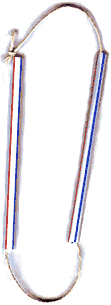


It is a very simple matter to make a formula for blowing bubbles using liquid household dishwashing soap and water. The water should be soft, or, better yet, distilled. Hard water or water heavy in mineral content will make fragile bubbles that will not last as long.
 As far as the dishwashing soap, most sources agree that the best to use is either Dawn or Joy (U.S.). Other brands will work, but not nearly as well. This is not a paid product endorsement, nor am I saying one soap cleans better than another does. It is simply a fact that Dawn and Joy make the best soap bubbles.
As far as the dishwashing soap, most sources agree that the best to use is either Dawn or Joy (U.S.). Other brands will work, but not nearly as well. This is not a paid product endorsement, nor am I saying one soap cleans better than another does. It is simply a fact that Dawn and Joy make the best soap bubbles.
The ratios to mix soap to water vary widely according to the source. Like any recipe, everyone has his or her own way of cooking the brew. Water quality and local climate (especially humidity) will determine what mixture works best in your area, so experiment to get the best formula to work with. The average range is 10 parts water to one part soap. Ultra Joy and Ultra Dawn are more sudsy, so less is required, maybe 15 or 20 parts water to one part soap. Mix well and allow to sit for a day or so to stabilize.
How long a bubble lasts is dependent on how long it can stay wet. Glycerin will slow down the drying time very well. So will sugar, Karo syrup (corn sugar syrup), and gelatin. Solutions with glycerin keep better over longer periods of time, but sugar and gelatin are less expensive and one or the other is probably already lying around the kitchen. Again, the amount added varies with climate and water, but start experimenting with around .10 parts (1/10 part,NOT10 parts!) gelatin, or .25 parts Karo syrup, sugar, or glycerin in the above formulae.
Most sources quote solutions within the above ranges. One significant variation is given by Professor Bubbles , who provides an excellent resource for bubble fans and practitioners. The formula is an especially stout mixture for very big bubbles, and uses 2 parts detergent, 4 parts glycerin, and 1 part white Karo syrup. This is serious stuff!
The basic wire loop - Take a short piece of thin but stiff wire and form a loop in it about 4 cm (1 1/2 inches) in diameter. Dip into the bubble solution and gently blow.
 Drinking straws
make fairly good bubble blowers. They will hold more bubble juice if 4 short slits ( 2" or 50mm) are cut at the bubble end. The resulting tabs should splay out.
Drinking straws
make fairly good bubble blowers. They will hold more bubble juice if 4 short slits ( 2" or 50mm) are cut at the bubble end. The resulting tabs should splay out.
The big bubble loop - Slide two drinking straws onto a piece of string about 1 meter (1 yard) long. Tie off the ends to form a loop. Hold the straws apart to form a big rectangle. Bring the straws together to close the rectangle and dunk it into a bucket of bubble juice (it is best to make a stiffer solution for this, using more glycerin and/or Karo syrup). Pull it out again and slowly separate the two straws. A film should form around the loop. If it doesn't break, pull the loop through the air to form a giant bubble.
Other things to try are funnels, the tops from plastic drink bottles, and the loop formed by a thumb and index finger. Experiment!
Soap bubbles are a layer of soap film on the outside, a layer of water molecules in the middle, and a layer of soap film on the inside. Light reflects from the first and second layer of soap film. The light waves interfere with each other, adding to or subtracting from each other's frequencies, which changes the color reflected.
The interference colors are determined by how far the light waves that are reflected from the inside layer must travel to meet the waves reflected from the outside layer. So the different colors of the bubble actually correspond to its thickness at different points.
Soap bubbles are elastic and will contract to form a sphere, which provides the most volume for the least surface area.
To build a bubble tank you need a large clear box that is open at the top. An empty aquarium will work well, but a tall narrow tank built from Plexiglas is better. It should be about 1 meter or 1 yard tall and 1 foot or 30cm square at the base.
Place a rag or dishtowel in the bottom of the box, and on top of that place a piece of dry ice. Let it sit for a minute or so. Some of the carbon dioxide in the dry ice will evaporate as carbon dioxide gas. Since it is denser than the surrounding air, it stays in the bottom of the box. If bubbles are now blown into the box, they will sink to the top of the carbon dioxide layer and float there. Don't actually blow into the box; you will probably blow out most of the carbon dioxide. Bubbles are semi-permeable, meaning there are tiny holes in them large enough to let some gas molecules through, but not others. Carbon dioxide can fit through these holes. Gradually, the carbon dioxide gas diffuses into the bubbles, causing them to grow.
If you don't have access to dry ice, you can mix a small amount of vinegar and baking soda in a container at the bottom of the chamber. They will bubble and produce carbon dioxide. Once the bubbling stops, there should be enough carbon dioxide for the bubbles to float.
The Science of Soap Films and Soap Bubbles
Demonstrating Science With Soap Films

This article was printed from the Bizarre Labs website at bizarrelabs.com